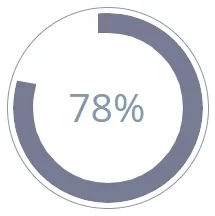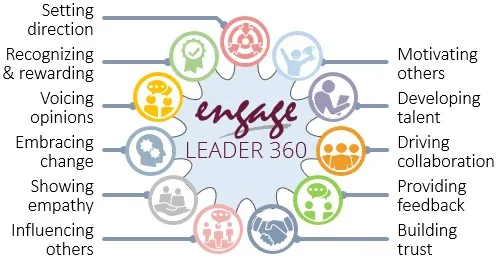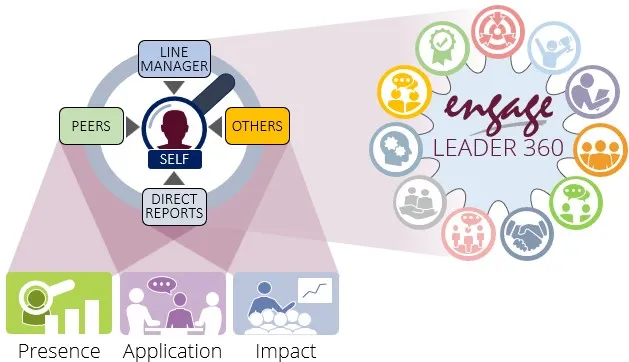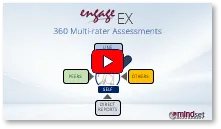
Engaged Leadership 360 Assessment
Develop and equip leaders at all levels of the organization to drive and sustain engagement in their teams
Leadership is one of the 4 biggest contributors to building engaged workplaces according to the 2022 Fortune World’s Best Workplaces’ study (Global Employee Engagement Benchmark Study). In this study nearly half of all employees, in over 37 countries, reported weak or poor relationships with their leaders.
leadership behavior
There is a 78% positive statistical correlation between the managers’ relationship with their teams and their teams’ engagement levels (Flow@Work Engagement Survey’s Reliability Study 2021)

Leadership sets the tone for organizational culture and has been proven to be a key factor in driving organizational success. Given the new challenges of employee well-being, remote and hybrid work and a looming recession, the role of leaders will become paramount to business success. Why, if leadership is key to driving employee engagement, do we see global engagement levels declining? The problem is caused by a number of factors such as:
- Leaders do not view engagement as a continuous process that requires constant attention, but see it as an annual survey,
- Leaders do not receive enough feedback from their stakeholders on how their behavior influences engagement,
- Leaders are not developed with a key focus on driving engagement and lack the skills and knowledge to create an engaged workforce.
However, it does not have to be this way. Organizations have an opportunity to adopt a different approach which enables and equips leaders to champion the engagement agenda.
Mindset's Engage Leader 360 Model
The Engage Leader 360 model leverages Mindset’s Flow@Work engagement model, and provides leaders with actionable feedback to drive and sustain engagement. Through this process, leaders become aware of their own behaviors, and, more importantly, what they can do differently to drive impact.

Engage Leader 360 collects feedback from superiors, direct reports, and peers, and includes a self-evaluation that provides the following insights:
- Feedback on 11 dimensions of engaged leadership behavior will provide the leader with an understanding of areas that could be developed, and how current strengths could be leveraged.
- Deeper insight into how leadership behavior can be changed with respect to 3 focus areas:
- Presence – does the leader visibly display this behavior?
- Application – does the leader apply this behavior?
- Impact – does the behavior lead to tangible impact?
- Presence – does the leader visibly display this behavior?
|
Book a free, no-obligation online demo of the Engage EX platform |
|
Contact us for more information or a quote for a turnkey solution |
Dimensions of Engaged Leadership Behavior
Our research shows that the following 11 behavioral dimensions are required for leaders to effectively drive sustained engagement:

- Setting Direction – a leader must be able to set the direction (rather than give directions) that will create a sense of shared purpose and guide behavior. This requires articulating the future in relatable language with clear expectations and guidance.
- Recognizing & Rewarding – a leader needs to recognize and reward good work to create a culture that celebrates excellence in an authentic and fair manner. By doing so, leaders encourage repeatable behavior and motivate employees to drive results.
- Voicing Opinions – it is important for leaders to create a culture where employees feel secure and encouraged to speak up without experiencing judgment or negative consequences.
- Embracing Change – leaders are required to create an environment that is resilient, adaptable, and responsive to change. This further implies that leaders need to maintain a positive attitude toward change and be equipped to navigate ambiguity.
- Showing Empathy – leaders will be most successful when they act with empathy, consider others’ perspectives, and act in a caring and responsible manner.
- Influencing Others – a leader needs to be able to influence the perspectives of others to align stakeholders toward achieving a common goal.
- Motivating Others – leaders require the ability to motivate and inspire others to act while balancing organizational demands and the resources required to be successful.
- Developing Talent – leaders need to develop and grow their teams in a way that balances organizational needs with personal ambitions and interests.
- Driving Collaboration – leaders need to be able to empower various stakeholders to work together in an inclusive environment to the benefit of all.
- Providing Feedback – a key characteristic of a good leader is the ability to provide constructive feedback that assists employees to improve and perform.
- Building Trust – to build trust as a leader, you must treat your team members with respect, speak truthfully (no matter how uncomfortable), demonstrate loyalty to the team, be transparent and provide open communication.
How Behavior can be Changed
The model provides actionable insights in terms of 3 focus areas that help leaders to change their behavior:

- Presence (does the leader display this behavior) – leaders cannot observe their own behavior and our model helps leaders to gain insight into whether they are actively demonstrating the behaviors described within the model. Self-awareness is the first step in driving tangible and actionable behavioral changes. The report will provide recommendations on how leaders can focus their behavior to ensure that employees observe and experience the behavior as intended. For example, leaders may believe that they are driving collaboration, yet others observe them to be obstructive and undermining cooperation.
- Application (does the leader apply this behavior) – a leader can apply specific steps to ensure that the behaviors defined in the model are applied within the context of the organization. Recommendations will be provided in a constructive way to assist the leader with the application aspect of his/her leadership skills. For example, the report will provide the leader with insight on how they can apply different feedback techniques to grow their team.
- Impact (does the behavior lead to tangible impact) – the success of the behavior may vary as a leader may be applying behavior but owing to the context or other factors, the behavior may not have the desired impact. This score being low indicates that the leader’s behavior does not have the desired impact on the culture in his/her team or department/ business unit. The recommendations in the report will provide the leader with feedback on adapting his/her behavior to ensure that the desired impact is achieved. For example, the leader will get a better understanding of how motivating others leads to higher levels of productivity and business impact.


